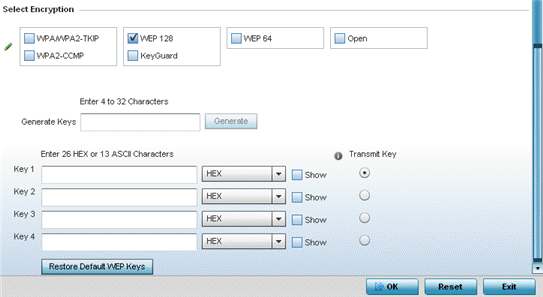WEP can be used with open, shared, MAC and 802.1 X EAP authentications. WEP is optimal for WLANs supporting legacy deployments when also used with 802.1X EAP authentication to provide user and device authentication and dynamic WEP key derivation and periodic key rotation. 802.1X provides authentication for devices and also reduces the risk of a single WEP key being deciphered. If 802.1X support is not available on the legacy device, MAC authentication should be enabled to provide device level authentication.
WEP 128 and Keyguard use a 104-bit key which is concatenated with a 24-bit IV (initialization vector) to form the RC4 traffic key. WEP may be all a small-business user needs for the simple encryption of wireless data. However, networks that require more security are at risk from a WEP flaw. WEP is recommended only when there are client devices incapable of using higher forms of security. The existing 802.11 standard alone offers administrators no effective method to update keys.
WEP 128 or Keyguard provides a more robust encryption algorithm than WEP 64 by requiring a longer key length and pass key. Thus, making it harder to hack through the replication of WEP keys.
To configure WEP 128 encryption on a WLAN:

| Generate Keys |
Specify a 4- to 32-character pass key and click Generate. TThe pass key can be any alphanumeric string. The access point, other proprietary routers, and WiNG clients use the algorithm to convert an ASCII string to the same hexadecimal number. Clients without these WiNG adapters need to use WEP keys manually configured as hexadecimal numbers. |
| Keys 1-4 | Use the Key #1-4 fields to specify key numbers. For WEP 128 (104-bit key), the keys are 26 hexadecimal characters in length. Select one of these keys for default activation by clicking its radio button. Selecting Show displays a key in exposed plain text. |
| Restore Default WEP Keys | Select this button to restore the WEP algorithm to its default settings. |
Select Reset to revert to the last saved configuration.